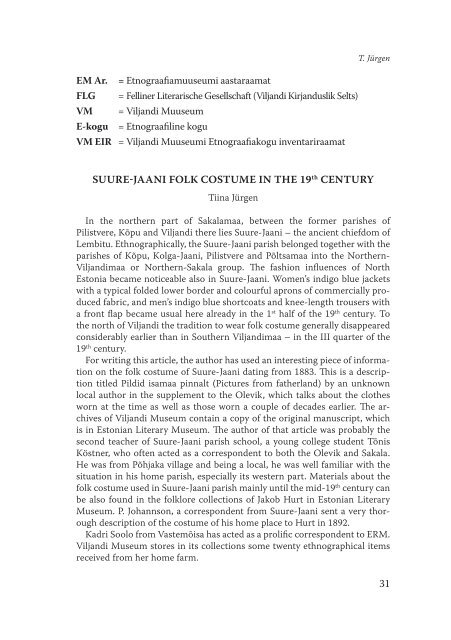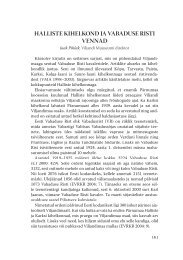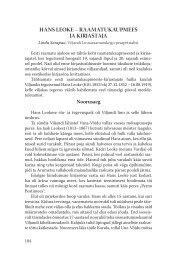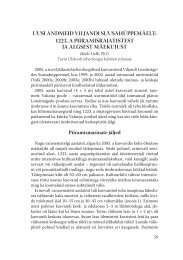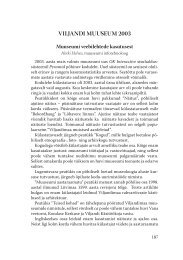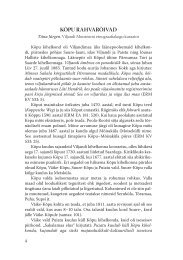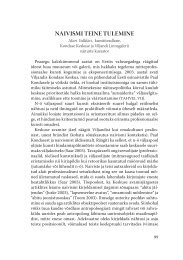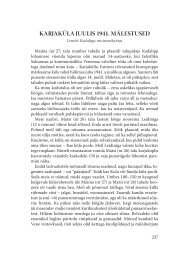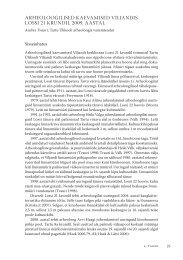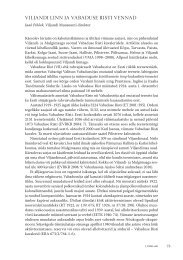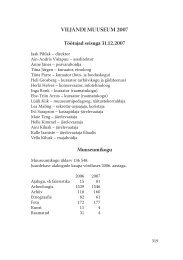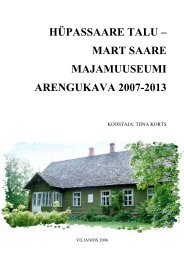SUURE-JAANI RAHVARÃIVAD - Viljandi Muuseum - Viljandimaa
SUURE-JAANI RAHVARÃIVAD - Viljandi Muuseum - Viljandimaa
SUURE-JAANI RAHVARÃIVAD - Viljandi Muuseum - Viljandimaa
- No tags were found...
Create successful ePaper yourself
Turn your PDF publications into a flip-book with our unique Google optimized e-Paper software.
T. Jürgen<br />
EM Ar. = Etnograafiamuuseumi aastaraamat<br />
FLG = Felliner Literarische Gesellschaft (<strong>Viljandi</strong> Kirjanduslik Selts)<br />
VM = <strong>Viljandi</strong> <strong>Muuseum</strong><br />
E-kogu = Etnograafiline kogu<br />
VM EIR = <strong>Viljandi</strong> <strong>Muuseum</strong>i Etnograafiakogu inventariraamat<br />
<strong>SUURE</strong>-<strong>JAANI</strong> FOLK COSTUME IN THE 19 th CENTURY<br />
Tiina Jürgen<br />
In the northern part of Sakalamaa, between the former parishes of<br />
Pilistvere, Kõpu and <strong>Viljandi</strong> there lies Suure-Jaani – the ancient chiefdom of<br />
Lembitu. Ethnographically, the Suure-Jaani parish belonged together with the<br />
parishes of Kõpu, Kolga-Jaani, Pilistvere and Põltsamaa into the Northern-<br />
<strong>Viljandi</strong>maa or Northern-Sakala group. The fashion influences of North<br />
Estonia became noticeable also in Suure-Jaani. Women’s indigo blue jackets<br />
with a typical folded lower border and colourful aprons of commercially produced<br />
fabric, and men’s indigo blue shortcoats and knee-length trousers with<br />
a front flap became usual here already in the 1 st half of the 19 th century. To<br />
the north of <strong>Viljandi</strong> the tradition to wear folk costume generally disappeared<br />
considerably earlier than in Southern <strong>Viljandi</strong>maa – in the III quarter of the<br />
19 th century.<br />
For writing this article, the author has used an interesting piece of information<br />
on the folk costume of Suure-Jaani dating from 1883. This is a description<br />
titled Pildid isamaa pinnalt (Pictures from fatherland) by an unknown<br />
local author in the supplement to the Olevik, which talks about the clothes<br />
worn at the time as well as those worn a couple of decades earlier. The archives<br />
of <strong>Viljandi</strong> Museum contain a copy of the original manuscript, which<br />
is in Estonian Literary Museum. The author of that article was probably the<br />
second teacher of Suure-Jaani parish school, a young college student Tõnis<br />
Köstner, who often acted as a correspondent to both the Olevik and Sakala.<br />
He was from Põhjaka village and being a local, he was well familiar with the<br />
situation in his home parish, especially its western part. Materials about the<br />
folk costume used in Suure-Jaani parish mainly until the mid-19 th century can<br />
be also found in the folklore collections of Jakob Hurt in Estonian Literary<br />
Museum. P. Johannson, a correspondent from Suure-Jaani sent a very thorough<br />
description of the costume of his home place to Hurt in 1892.<br />
Kadri Soolo from Vastemõisa has acted as a prolific correspondent to ERM.<br />
<strong>Viljandi</strong> Museum stores in its collections some twenty ethnographical items<br />
received from her home farm.<br />
31


